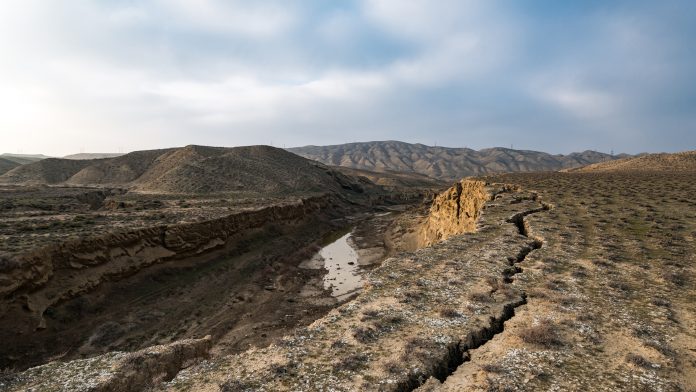Researchers believe that a newly discovered hidden mechanism is the reason behind an unexpected Alaskan strike-slip earthquake.
The team, consisting of Kevin P. Furlong, Professor of Geoscience at Penn State, and Mathew Herman, Assistant Professor of Geology at California State University, were intrigued by the unusual location of this major strike-slip earthquake – resulting in them conducting a detailed analysis of the occurrence. Their research is supported by The National Science Foundation.
Furlong said: “The first earthquake that occurred in the Shumagin Islands region of Alaska was the right type. The second one was a strike-slip earthquake, and that made no sense. That was the part that got us thinking.”
What is a strike-slip earthquake?
This particular type of earthquake occurs on what is known as “strike-slip faults”, which are fractures in the Earth’s crust in which two crustal blocks move parallel to each other but in opposite directions. These faults are a consequence of horizontal displacements; here, the two plates are held together by friction until a substantial amount of strain is built up, which, when released, causes a strike-slip earthquake. There is almost no vertical offset caused by a strike-slip fault, whereas there is a substantial lateral offset.
Some of the most notable strike-slip faults are located at the border between obliquely translational oceanic and continental tectonic plates. These strike-slip faults include the San Andreas Fault and Anatolian Fault, both of which have been responsible for some significant seismic shake-ups. However, the problem is that one of these types of earthquakes occurred in the Alaska-Aleutian subduction zone, a place where strike-slip earthquakes are not expected.
Subduction zone earthquakes
Subduction zones are the areas in which two tectonic plates converge, with one of the plates sliding underneath the other. If the plates slide by each other smoothly, they are classified as unlocked or uncoupled. Contrastingly, suppose both plates become hung-up on each other. In that case, the friction holding them together will eventually be overwhelmed to the point of release, which consequently results in an earthquake. Plates that are considered to be locked or coupled, with points of locking and unlocking able to occur at different areas of a subduction zone, typically produce major subduction earthquakes.
The Alaska-Aleutian subduction zone is a staggering 2,500 miles long and is formed by the Pacific plate and North American plate travelling towards each other at a speed of 6-7 centimetres per year, spanning from Russia to Alaska, with the Pacific plate subducting below the North American plate, due to its being much denser. Throughout history, the Alaska-Aleutian subduction zone has been the culprit of many cataclysmic earthquakes, such as the Good Friday Earthquake of 1964. This catastrophic natural disaster recorded an astounding magnitude of 9.2, making it the second-largest earthquake ever recorded, devastating Anchorage and numerous Alaskan towns, in addition to causing a tsunami responsible for deaths as far away as California.
The Shumagin Gap earthquake
In 2020, a subduction zone interface earthquake occurred to the east of the Shumagin gap – in an area of the Alaska-Aleutian subduction zone in which these types of earthquakes are expected and have happened before. This area on Shumagin Gap’s edge is considered locked, meaning that this earthquake was not really shocking. However, the actual Shumagin Gap area of the subduction zone was thought to be unlocked, meaning that geoscientists believed that no major earthquakes would occur here, so when a strike-slip earthquake occurred in the Pacific Plate directly in the centre of the gap, scientists were stunned. These events sparked Furlong and Herman’s investigation, who believed the earthquake was caused by a strike-slip fault perhaps a relict fault that had developed at the mid-oceanic ridges, millions of years previously.
“To have an earthquake of this size, there must be a fault in the subducting Pacific Plate, but we just can’t see it,” explained Furlong.
Investigating the strike-slip earthquake
The scientists modelled the earthquakes to examine this hypothesis, utilising typical seismologic data but also data from the small tsunamis that transpired due to the second earthquake. Fascinatingly, they discovered that the transition from the coupled to uncoupled sections of the subduction zone produced strains that caused an earthquake on this fault in the subducting plate. Surprisingly it was the uncoupled nature of the Shumagin Gap, that made an earthquake in that region more likely than if it were coupled.
Herman said: “The potential for unusual earthquakes in these regions makes sense from our computational models. But it is still pretty counterintuitive that making the expected kind of earthquakes less likely actually makes other types of big earthquakes more likely.”
The Tsunami data, in particular the record of past tsunamis was particularly beneficial for the researchers, as some areas of the Shumagin Gap lacked crucial GPS Data to constrain coupling patterns. Paleoseismologists are able to peer at past events through the deposits left by prior earthquakes, with previous tsunami data not indicating any previous large-scale earthquakes in this area, reinforcing the idea that this is an uncoupled region.
“There are probably other areas that are uncoupled, so we assume that they are safe from earthquakes, but they aren’t. They are unlikely to have a big subduction earthquake, but they could still have a strike-slip earthquake like the 2020 Shumagin Gap event. If there are people in the area, it could do damage with shaking and a small tsunami,” explained Furlong.
The scientists believe that due to this literally ground-breaking information about plate tectonics – a field in which knowledge is incredibly integrative, that we need to be increasingly vigilant when considering earthquakes on these boundaries, as major events and associated destruction could arise in the places that we least expect it.
This research was originally published in Science Advances: Triggering an unexpected earthquake in an uncoupled subduction zone.








